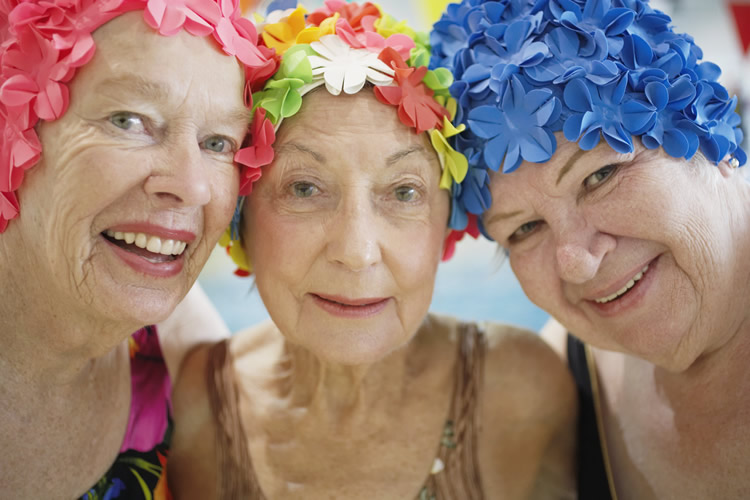Adults over 50 who are caring for ageing parents are not like other fitness clients of similar age.
For starters, caregivers tend to be less healthy. A study by the insurance company MetLife noted that “adult children 50+ who work and provide care to a parent are more likely to have fair or poor health than those who do not provide care to their parents” (MetLife 2011). Another study showed that 17% of caregivers felt their health had gotten worse as a result of their caregiving responsibilities (Feinberg et al. 2011).
The MetLife study estimates that 10 million adults over the age of 50 are caring for their parents. They’re taking care of “instrumental” activities such as grocery shopping, transportation and finances, and they’re helping out with basic activities of daily living such as dressing, bathing and feeding. When all the additional support (housework, paperwork, errands) is factored in, the “opportunity costs” can be exorbitant—particularly when viewed in terms of the caregivers’ loss of leisure and personal time.
All of this exposes adult caregivers to declining health, chronic diseases and depression, the MetLife study reported. Fitness professionals who understand the unique needs of older caregiver clients will be better able to provide targeted, appropriate services.
GREAT EXERCISES FOR OLDER CAREGIVERS
These five exercises are recommended by Pamela Hernandez, ACSM CPT and ACE health coach:
- Bird dog. Bird dog strengthens your abs and lower back and your gluteal muscles while improving your balance. Start on your mat in an all-fours position. Extend one arm forward with fingertips reaching for the wall in front of you, while extending the opposite leg with the heel reaching for the wall behind you. Draw your bellybutton in toward your spine to help engage the transversus abdominis (the deep muscle band that runs around your midsection). Hold for 5 seconds, then repeat with the opposite arm and leg. Repeat the exercise 5 times on each side.
- Stability ball roll-out. This works not only your stabilising transversus abdominis but also the latissimus dorsi. Start on your mat in a kneeling position with a stability ball as close as possible in front of you. Place your hands on the ball in prayer position, close to your body. Roll the ball out in front of you while keeping your hips locked into position, with your body forming a straight line from knee to shoulder. Stop when the ball is under your forearms, and hold the position for 10 seconds. Then reverse the movement without bending your hips. Repeat 5 times.
- Superman. Superman targets the gluteus, hamstrings and lower back. Lie facedown on your mat with your arms stretched out straight in front of you. Squeeze your gluteus and your lower-back muscles to lift your knees and chest off the mat, like Superman taking off. Hold for 5 seconds, then lower yourself back to the mat in a slow, controlled motion. Think of lengthening your body rather than lifting it up high. Repeat the exercise 5 times.
- Plank. The plank builds strength in the core muscles, including the abs, and improves stability. Kneel on your mat. Lean forward to rest your elbows and forearms on the mat, with elbows directly below the shoulders. Tighten everywhere your belt touches, then lift your knees. Hold the knees below the hips, or lengthen fully into a long-leg plank. Hold for 20 seconds, then release for 10 seconds. Repeat several times.
- Windshield wiper. This exercise works the obliques and helps with mobility and flexibility in the lower back. Lie on your back with feet off the floor and knees over hips, bent at a 90-degree angle. Place your arms in a “T” at shoulder height, with palms facing the ground. Rotate your knees to the left, keeping your right shoulder pinned to the ground. Go only as far as you can without the right shoulder coming up. Repeat on the right side, keeping the left shoulder down. Repeat the exercise 5 times on each side.
To read more about the physical needs of older caregivers, please see “Tips for Working With Older Caregivers” in the online IDEA Library or in the June 2015 print issue of IDEA Fitness Journal. If you cannot access the full article and would like to, please contact the IDEA Inspired Service Team at (800) 999-4332, ext. 7.
References
Feinberg, L., et al. 2011. Valuing the invaluable: 2011 update—the growing contributions and costs of family caregiving. AARP Public Policy Institute. Accessed Feb. 10, 2015. http://assets.aarp.org/rgcenter/ppi/ltc/i51-caregiving.pdf.
MetLife. 2011. The MetLife study of caregiving costs to working caregivers: Double jeopardy for Baby Boomers caring for their parents. MetLife, Mature Market Institute. Accessed Feb. 10, 2015. www .caregiving.org/wp-content/uploads/2011/06/mmi-caregiving-costs-working-caregivers.pdf.

